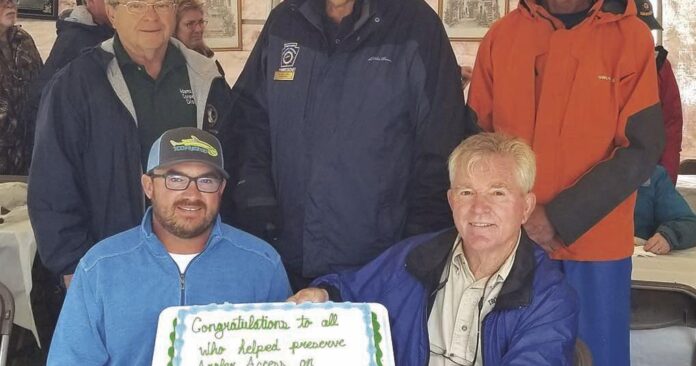The patience, perseverance and partnerships behind a unique 58-acre land deal along the Conewago Creek, and 40 years of teamwork by two Trout Unlimited chapters that take care of it, were great reasons for a hurricane Ian hurrah last Saturday.
After two years of anxiety, excitement, and hard work within a determined team, the Land Conservancy of Adams County officially purchased and took ownership of the 58 acres from Knouse Foods on Dec. 30, 2021, and immediately transferred to the Fish and Boat Commission.
Ground was broken on Aug. 11 for work on the parking area and other features at the site along Ziegler Mill Road.
Richard Lewis, Fish and Boat commissioner and Dave “Trout King” Swope, both members of the Adams County Chapter of Trout Unlimited (ACTU), were in the first meeting and played consistent roles.
“There was concern that a new owner might not want to allow catch-and-release fly-fishing only and might not even want to allow public access for fishing,” Lewis said.
Knouse owned the property since 1986 and allowed access for decades. An agreement in 1998 gave the PFBC access to manage the stream and public access. A decades-long partnership with ACTU allowed exceptional and relentless stream improvement work by the local and Northern Virginia chapters of Trout Unlimited.
Members of NVTU were on hand last Saturday to help celebrate the 40-year partnership for the Conewago.
The Adams County Office of Planning and Development, Watershed Alliance of Adams County, Land Conservancy of Adams County (LCAC), Adams County Conservation District, Adams County Commissioners, and others were also in the mix that made the 58-acre deal happen.
The LCAC holds roughly 175 conservation easements that cover 12,200 acres, including open space like farm and forest land, water resources, and wildlife habitat.
ACTU signed a 25-year long-term management and protection agreement with the PFBC, so ACTU can continue its stream improvement work and add trails, fencing, signage, and build an access road and anglers parking lot.
It’s going to be multi-functional. There will be educational stations where you can walk and identify some of the stream’s ecosystem.
“There was a common thread that ran through every one of the people who helped,” Richard said. “Their interest in the environment and conservation and wildlife. That’s what the driver was. Just our own conservation ethic.”
The Pennsylvania Fish and Boat Commission is offering a new round of Boating Facility Grants to help communities capitalize on the surge in new boating activity.
The Boating Facility Grant Program provides grants for planning, acquisition, development, expansion, and rehabilitation of public boating facilities on Commonwealth waters.
Townships, boroughs, and municipal and county governments are encouraged to apply. Nonprofit groups (501c3) including land trusts, conservancies, and watershed associations are also eligible. Private businesses and service clubs are not eligible for direct funding but are encouraged to partner with their local county or municipality.
“Many existing boating access points quickly reach their capacity with boaters eager to be on the water,” said Tim Schaeffer, PFBC Executive Director. “Funds awarded through this grant program can help communities improve existing access areas or develop something new to serve local residents and attract recreational boaters to their region.”
Applicants can seek grants for site acquisition, development, expansion, prevention of the spread of aquatic invasive species, and rehabilitation of recreational boat access facilities. Eligible construction projects may include boat ramps, courtesy floats, restrooms, access roads, parking areas and signs. Funds may also be used to make facilities ADA compliant.
Funding requests must have a 50 percent match. The deadline for applications is December 30.
More information about the Boating Facility Grant Program and application form can be found on the PFBC website www.Fishandboat.com.
Blue Catfish are being restored to the Ohio River basin in western Pennsylvania by the Fish and Boat Commission this week.
The cats are native to the major rivers in the Ohio River basin and considered highly invasive in the Atlantic Slope basins of the Delaware River, Potomac River, Susquehanna River, and Lake Erie.
Able to reach weights over 100 pounds and a habit of feeding during cooler months, Blue Catfish can provide year-round trophy catfish angling in the Ohio River and its major tributaries.
The goal of the Three Rivers Blue Catfish Restoration Plan is to ultimately establish a self-sustaining, naturally reproducing population of Blue Catfish, North America’s largest catfish species, in the Ohio River, Monongahela River, and lower Allegheny River.
Due to pollution and habitat alteration, Blue Catfish were eliminated from Pennsylvania in the early 1900s.
The plan pertains specifically to the commission-led restoration of Blue Catfish in the Three Rivers only. They are a large, riverine species not considered native to the numerous lakes in the Ohio River basin. Stocking will not be considered for these waterbodies.
It is illegal for individuals to stock Blue Catfish into any water of Commonwealth.
Blue Catfish stocking in the Ohio River will begin with fingerlings (3-5 inches) during fall 2022 and yearlings (8-10 inches) in 2023 and beyond.
The commission will monitor and assess restoration efforts in the Ohio River every three years beginning in 2025.
• The fall trout stocking of the fly-fishing area of the Conewago Creek by the Pennsylvania Fish and Boat Commission was rescheduled from Oct. 5 to Oct. 26. Fish are coming from Huntsdale, and the group will be meeting at Letterkenny Reservoir at 10 a.m.
Credit: Source link





























